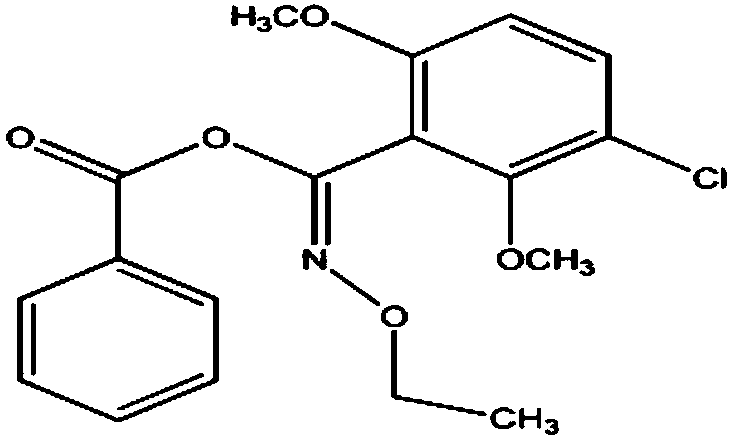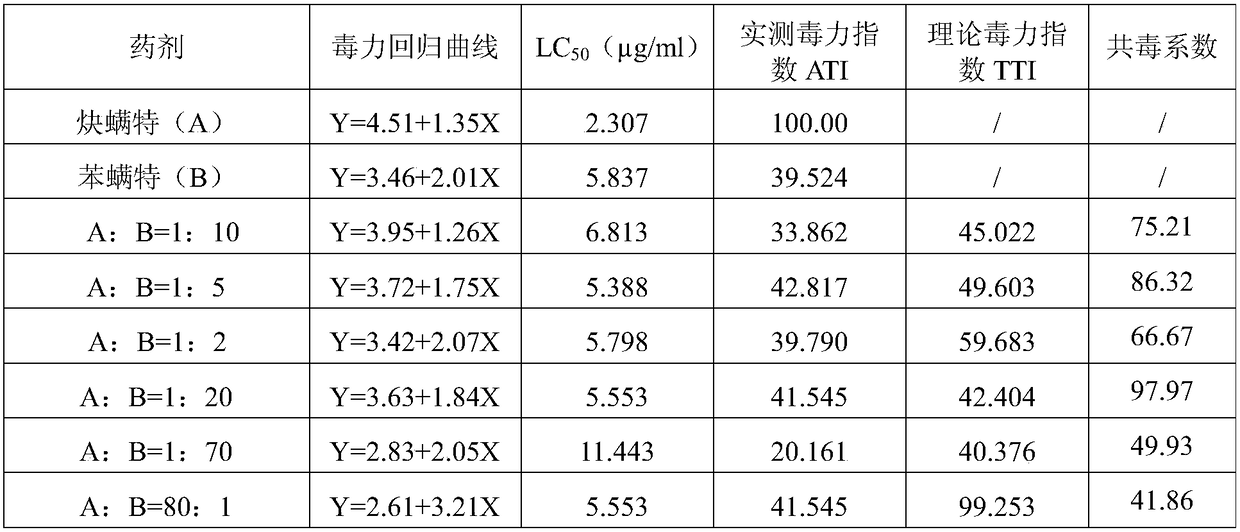A kind of synergistic insecticidal composition containing propargate and benzapter and its application
An insecticidal composition, the technology of benzadil, applied in the field of pesticides, can solve the problems of high cost of pesticides for farmers, easy to produce drug resistance, and inability to protect crops, so as to reduce the amount of pesticides used in the field, reduce environmental pollution and pesticide residues, and reduce The effect of preventing and controlling labor costs
- Summary
- Abstract
- Description
- Claims
- Application Information
AI Technical Summary
Problems solved by technology
Method used
Image
Examples
Embodiment 1
[0022] Combined Toxicity of Different Proprietary Proprietate and Benfate
[0023] Weighing propargid and benzadil were prepared in different proportions by conventional preparation methods to prepare a propargid-benzadil suspension concentrate with a main active ingredient weight percentage of 30%. See Table 1 for specific proportions.
[0024] The toxicity of propargite, benzapter and their compound samples to Panonychus citrus was determined by dipping slides. Each treatment was repeated 3 times, and 30 heads were treated at each concentration. 50 Calculate the co-toxicity coefficient according to Sun Yunpei's method:
[0025] Table 1 Toxicity determination and co-toxicity coefficient of propargite, benzapter and their compound samples against Panonychus citrus
[0026]
Embodiment 2
[0028] Weighing propargite and benzapterate were prepared in different proportions by conventional preparation methods to prepare propargite-benzapterate emulsifiable concentrate with a main active ingredient weight percentage of 30%. See Table 2 for specific proportions.
[0029] The test method adopts the leaf butterfly spray method (refer to "NY / T 1154.13-2008 Pesticide Indoor Bioassay Test Guidelines for Insecticides. Part 13: Leaf Butterfly Spray Method") to determine the pair of propargite, benzapter and their compound samples. Toxicity of Tetranychus cinnabarinus in cotton, repeated 3 times for each treatment, with LC 50 Calculate the co-toxicity coefficient according to Sun Yunpei's method:
[0030] Table 2 Toxicity determination and co-toxicity coefficient of propargite, benzapter and their compound samples on cotton Tetranychus cinnabarinus
[0031]
Embodiment 3
[0033] Weigh 5g of propargite, 20g of benzate, 4g of calcium dodecylbenzenesulfonate, 3g of phenethylphenol polyoxyethylene ether, and xylene to 100g, and put the above raw materials into the mixing kettle according to the conventional method of preparing emulsifiable concentrate Mixed to form propargite-benzant emulsifiable concentrate whose main active ingredient is 25% by weight.
[0034] Adopt the sample of embodiment 3 to carry out the field test of field prevention and control of citrus Panonychus citrus. Check the results of 3 days, 7 days, and 14 days. The test results are shown in Table 3:
[0035] Table 3 example 3 sample is to the field test result of citrus Panonychus
[0036]
[0037] It can be seen from Table 3 that Example 3 has excellent quick-acting effect on Panonychus citrus, and has a relatively long duration of action, and performs well in the field. It is an excellent agent for preventing and controlling Panonychus citrus.
PUM
 Login to View More
Login to View More Abstract
Description
Claims
Application Information
 Login to View More
Login to View More - R&D
- Intellectual Property
- Life Sciences
- Materials
- Tech Scout
- Unparalleled Data Quality
- Higher Quality Content
- 60% Fewer Hallucinations
Browse by: Latest US Patents, China's latest patents, Technical Efficacy Thesaurus, Application Domain, Technology Topic, Popular Technical Reports.
© 2025 PatSnap. All rights reserved.Legal|Privacy policy|Modern Slavery Act Transparency Statement|Sitemap|About US| Contact US: help@patsnap.com



